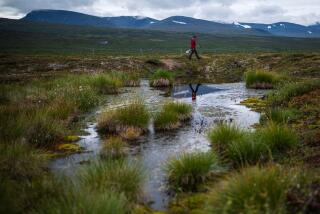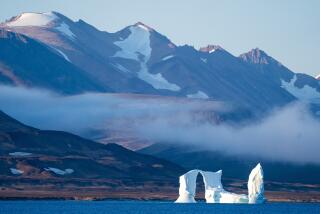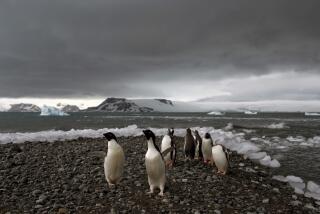Arctic Ozone Loss Held Bigger Threat : More Populous Region Periled by Depletion Over North Pole
- Share via
MOUNTAIN VIEW, Calif. — The depletion of ozone over the North Pole may be a greater threat than the more extensive weakening of the vital protective layer over Antarctica because the North Pole is closer to more people, according to scientists who are embarking on a two-month aerial expedition to study the upper atmosphere over the Arctic.
Ozone in the stratosphere far above the Earth is being destroyed over both poles, especially at the South Pole, where a hole as large as the continent of Antarctica emerges in the ozone layer each spring. Evidence indicates that the ozone, which protects the planet from ultraviolet solar radiation that can cause skin cancer, is being destroyed by chemical compounds, known as chlorofluorocarbons.
The same process is believed to be taking place over the North Pole, although the ozone hole there is much smaller, and thus the threat would seem to be less serious.
But that assumption, according to Estelle Condon, manager of the Airborne Arctic Stratospheric Expedition, may be very wrong.
Small Reduction
Even a small reduction in ozone over the Arctic “could be more serious because most of the people reside in the Northern Hemisphere,” Condon told a press conference Thursday at Ames Research Center here, as scientists prepared to test-fly the experiments that they hope will tell them much about the extent of the problem over the Arctic.
“We’re seeing evidence of the influence of man on his environment on a global scale,” Condon said.
The ozone problem must be fully understood, she said, because “every living thing on the planet has evolved under the protective shield of ozone.”
About 150 scientists will be taking part in the project over the next two months, collecting data over the North Pole as they did over the South Pole last year.
The expedition, which will begin in early January, is sponsored by the National Aeronautics and Space Administration and the National Oceanic and Atmospheric Administration. It will use two NASA aircraft, each loaded with instruments that will analyze the atmosphere and even collect air samples for further study back on the ground.
The planes will be based in southern Norway for the expedition.
Sister Ship
One of the aircraft is a high-altitude sister ship to the old U-2 spy plane. Called an ER-2, the craft, which is basically a rocket-powered glider, can climb to 70,000 feet, much higher than any other civilian aircraft.
“That’s really on the edge of space,” said John Arvesen, chief of operations for the ER-2.
The ER-2 carries only one person--the pilot--who must also conduct the experiments. The atmosphere is so thin at that altitude that the pilot will wear a spacesuit similar to those worn by astronauts aboard the space shuttle.
The plane will roam over most of the Arctic, but it will always remain within 250 miles of land so it could glide to a landing if necessary.
The solitary role of the ER-2 pilot will stand in stark contrast to the other participants in the program. A DC-8 will make at least 14 flights along the lower edge of the stratosphere, and the plane is literally a flying laboratory.
Instruments have been crammed into nearly every inch of space aboard the DC-8. About 30 scientists, representing 10 scientific teams, will run the experiments on flights that will last up to 12 hours.
Survival of Life
The purpose of the experiments will be to determine more about the chemistry and the mechanics that are allowing man-made compounds to destroy an atmospheric layer that could be essential to the survival of life on Earth, according to Brian Toon, flight scientist for the DC-8.
Most of the scientists participating in the project are veterans of last year’s expeditions over Antarctica, but the situation over the Arctic is quite different.
Although the North Pole is closer to inhabited areas, and thus depletion of ozone there could be particularly threatening, the rate of depletion in the north is far less than in the south, apparently because of subtle differences between the two regions.
Toon said the principal factor apparently is that the stratosphere over the South Pole is about 20 degrees colder than over the North, allowing more ice clouds to form in the south’s upper atmosphere.
The clouds are believed to play a key role in ozone depletion by releasing chlorine from the chlorofluorocarbons. The chlorine then lies in wait for the catalyst--sunlight--to send it into an ozone-destroying frenzy. A single chlorine molecule can destroy tens of thousands of molecules of ozone.
Spring Sunlight
Over Antarctica, the spring sunlight activates the chlorine, which in turn breaks down ozone into ordinary oxygen.
But in the upper atmosphere over the Arctic, fewer ice clouds are believed to form, primarily because the temperature is a balmy 130 degrees below zero. Toon also said the northern regions are far more diverse--with mountains and islands and continents--than the south, which has only one continent and a lot of ocean. That, in turn, apparently produces a dynamic weather system that disrupts the process before a large ozone hole can be formed.
If the system collapses soon after the arrival of the spring sun, the hole does not have a chance to grow as much, said Pat McCormick of NASA’s Langley Research Center.
“The Arctic is a far more dynamic system” than Antarctica, he said.
The aerial expeditions are part of a larger international program. Elsewhere, balloons laden with instruments will be launched from Barrow, Alaska, and from various countries around the North Pole. NASA and National Oceanic and Atmospheric Administration satellites will also train their instruments on the Arctic.
The cost of the program is estimated at $8 to $10 million.
More to Read
Sign up for Essential California
The most important California stories and recommendations in your inbox every morning.
You may occasionally receive promotional content from the Los Angeles Times.










